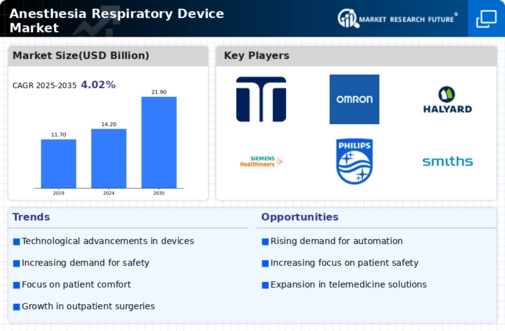Market Growth Projections
The Global Anesthesia Respiratory Device Market Industry is poised for substantial growth, with projections indicating a market size of 14.2 USD Billion in 2024 and an anticipated increase to 21.9 USD Billion by 2035. This growth trajectory suggests a robust demand for anesthesia respiratory devices, driven by factors such as technological advancements and rising surgical procedures. The market is expected to experience a compound annual growth rate (CAGR) of 4.02% from 2025 to 2035, highlighting the industry's resilience and adaptability in meeting the evolving needs of healthcare systems globally.
Technological Advancements
Technological innovations play a pivotal role in shaping the Global Anesthesia Respiratory Device Market Industry. The introduction of smart anesthesia machines, which integrate advanced monitoring systems and data analytics, enhances the precision and safety of anesthesia delivery. These devices not only improve patient outcomes but also streamline workflow in operating rooms. As hospitals increasingly invest in cutting-edge technology, the market is expected to grow, with projections indicating a rise to 21.9 USD Billion by 2035. This trend underscores the importance of continuous innovation in meeting the evolving needs of healthcare providers.
Increasing Surgical Procedures
The Global Anesthesia Respiratory Device Market Industry experiences growth driven by the rising number of surgical procedures worldwide. As healthcare systems expand and improve, the demand for surgical interventions increases, necessitating advanced anesthesia respiratory devices. In 2024, the market is projected to reach 14.2 USD Billion, reflecting the growing reliance on these devices for patient safety and comfort during surgeries. This trend is likely to continue as more hospitals adopt innovative technologies to enhance surgical outcomes, thereby propelling the market forward.
Regulatory Support and Guidelines
Regulatory frameworks and guidelines established by health authorities significantly impact the Global Anesthesia Respiratory Device Market Industry. Governments worldwide are increasingly focusing on patient safety and quality of care, leading to stringent regulations for anesthesia devices. Compliance with these regulations not only ensures the safety of patients but also fosters innovation within the industry. As manufacturers adapt to these evolving standards, the market is likely to see an influx of new products designed to meet regulatory requirements. This dynamic environment may further stimulate market growth as healthcare providers seek compliant and effective solutions.
Growing Awareness of Patient Safety
The Global Anesthesia Respiratory Device Market Industry is propelled by the increasing awareness of patient safety among healthcare professionals and patients alike. As the focus on quality care intensifies, there is a growing demand for devices that enhance monitoring and minimize risks during anesthesia administration. This heightened awareness drives hospitals to invest in advanced anesthesia respiratory devices that offer improved safety features. Consequently, the market is expected to expand as healthcare institutions prioritize patient safety in their operational protocols, ensuring that they remain competitive in an evolving healthcare landscape.
Rising Prevalence of Respiratory Disorders
The Global Anesthesia Respiratory Device Market Industry is significantly influenced by the increasing prevalence of respiratory disorders. Conditions such as chronic obstructive pulmonary disease (COPD) and asthma necessitate effective management during surgical procedures, driving demand for specialized anesthesia respiratory devices. As the global population ages and the incidence of these disorders rises, healthcare providers are compelled to adopt advanced devices that ensure optimal respiratory support. This growing need is expected to contribute to a compound annual growth rate (CAGR) of 4.02% from 2025 to 2035, reflecting the market's responsiveness to changing patient demographics.




















Leave a Comment